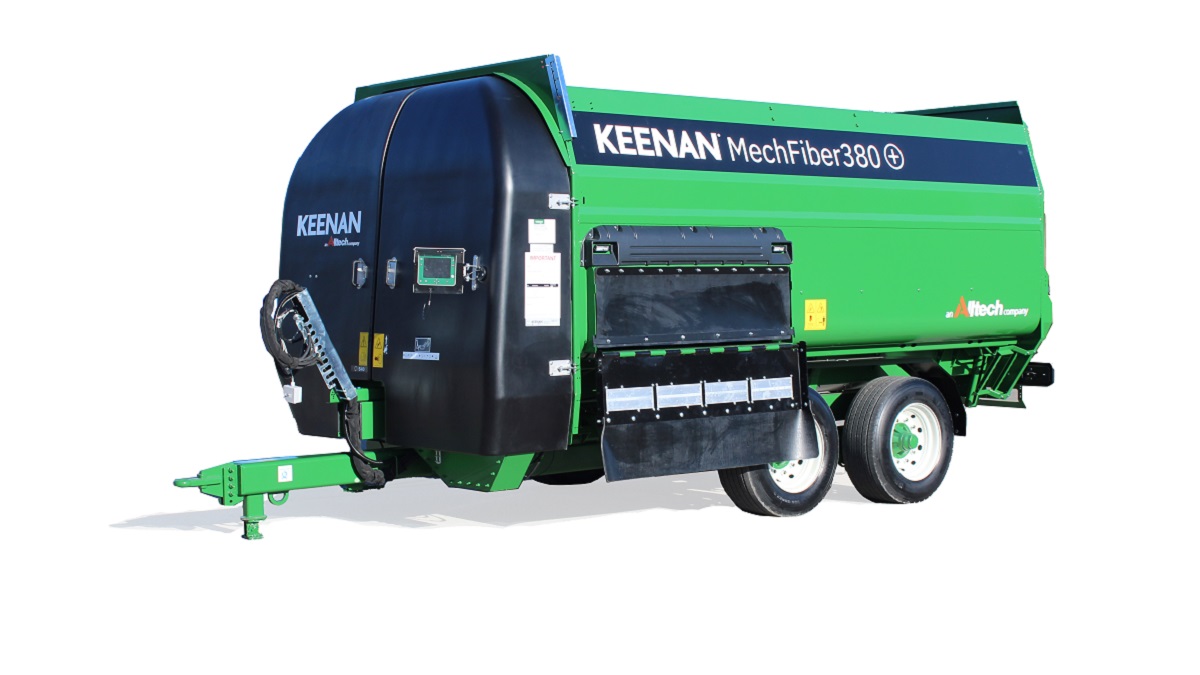
North America

Europe

Latin America

Asia Pacific

Africa

Middle East

North America

Europe

Latin America

Asia Pacific

Africa

Middle East
[DUNBOYNE, Ireland] – Alltech is a global leader in animal nutrition, backed by 45 years of scientific research. The company produces premium feed additive products and works with global regulatory agencies to meet their requirements. For more than a decade, the company’s attenuated total reflectance Fourier transform infrared spectroscopy (ATR–FTIR) chelation assay has been relied upon by the industry to ensure that only the highest-quality products enter the market, to ensure fair market competition, and to prevent feed additive fraud.
“With new trace mineral chelate products continuously being developed, in addition to products with increased mineral concentration, the use of validated assays such as that developed by Alltech will ensure that such chelates meet EU regulatory requirements,” said Dr. Colm Moran, chief regulatory officer at Alltech. “This further adds to their safety and efficacy characteristics. Apart from enabling producers to meet regulatory requirements, assessment of such chelates via this assay will enable the EU to combat feed additive fraud. In doing so, the EU can further protect its agricultural sector by upholding standards through robust monitoring and rigorous enforcement of regulations.”
The process of complexing or chelating elements such as zinc or manganese to generate a trace mineral chelate typically involves reacting inorganic mineral salts with a suitable bonding group such as a peptide or amino acid, after which the mineral becomes part of a biologically stable structure. The chemistry behind chelation has created a great deal of confusion in the animal feed industry.
“Establishing the degree of complexation is important for both regulatory and practical purposes. Just as regulatory agencies require complete characterisation of medicinal products, similar data is necessary for trace mineral chelates to ensure their safety and efficacy,” said Dr. Richard Murphy, research director at Alltech. “If the metal ion is not complexed, its use will confer no additional benefit over that of a metal salt. Additionally, control methods allowing for the detection of products which are merely blends of carrier and inorganic salts are important to prevent the sale of fraudulent materials.”
In 2017, researchers at the Alltech European Bioscience Centre in Dunboyne, Ireland, assessed several different methodologies to determine the degree of metal complexation in commercially available chelates of protein hydrolysate (proteinates), thereby enabling more complete characterisation and control of these products. Potential methodologies which were identified included both the ATR–FTIR and powder X–Ray diffraction (PXRD). Both techniques are well established and widely available, and data can be acquired rapidly. They are also non-destructive, so that the same sample can be analysed by both methods in different laboratories.
Subsequent to this, the method was published under peer review (Cantwell et al., 2017) and made available to the industry as a whole, enabling other manufacturers to independently assess their own products. Additional work by Byrne et al., (2023) extended on the earlier work and validated the assay for use with higher concentration trace mineral chelates of protein hydrolysate.
The validated ATR-FTIR spectroscopy method is product specific, and while its use is applicable to the general class of chelates referred to by EFSA as “chelates of protein hydrolysate” (proteinates), the published assay has only been verified for the proteinate Bioplex®, produced by Alltech. As the characteristics of any proteinate will depend on the protein source used to produce the hydrolysate, the hydrolysis process, and the percentage of metal present, the assay will need to be validated and verified in a product-specific fashion.
“Product-specific assay validation is critical in this instance as the hydrolysis procedure plays a critical role in the production of proteinate products and varies greatly between manufacturers,” said Murphy. “As such, to obtain accurate data on the extent of chelation for specific chelate products, generation of appropriate standards and calibration curves, along with method verification and validation procedures, must be done for each specific product type.”
For more information about Alltech’s mineral management solutions, visit alltech.com/en-ie/mineral-management.

With new trace mineral chelate products continuously being developed, in addition to products with increased mineral concentration, the use of validated assays such as that developed by Alltech will ensure that such chelates meet EU regulatory requirements
Sürdürülebilirlik sığır endüstrisi için gerçekten ne anlama geliyor?
Bazıları bunu yalnızca popüler bir pazarlama söylemi olarak görse de sürdürülebilirlik, mevcut ihtiyaçları karşılarken geleceği riske atmadan hareket etmeyi ifade ediyor. Hayvancılıkta ise bu, giderek daha karmaşık hale gelen çevresel, sosyal ve ekonomik faktörler arasında bir denge kurmayı gerektiriyor.
Tarımda sürdürülebilirliğin evrimi
İnanması zor gelebilir, ancak “sürdürülebilirlik” terimi tarımın kelime hazinesine oldukça yeni eklenmiştir. 1970’lerden önce yalnızca tarımda değil, İngilizce dilinde de bu kelime neredeyse hiç bilinmiyordu. Zamanla tarımda oldukça önemli bir kavram haline geldi ve başlangıçta israfı en aza indirmek, kaynakları korumak ve ekosistem dayanıklılığını teşvik etmek olarak tanımlandı.
Tanımlar geliştikçe, sürdürülebilirlik çevresel, sosyal ve ekonomik açıdan üç temel ilkeye dayanan bir kavrama dönüştü. Ve hayvancılık yapan üreticiler için bu ilkeler hala bir başlangıç olarak görünüyor.
Hayvancılık sektöründe beş sürdürülebilirlik ilkesi
Sektördeki sürdürülebilirlik anlayışı geniş bir çerçeve gerektiriyor. Aşağıdaki beş temel ilke bu bakımdan üreticiler için uygulanabilir bir yol haritası olabilir:
Sürdürülebilirlik neden önemlidir?
Dünya nüfusu hızla artıyor ve 2050 yılına kadar nüfusumuza 2,3 milyar daha insanın eklenmesi bekleniyor. Bu büyüme, global gıda talebinde %60'lık bir artış anlamına geliyor, bu da gelişmiş ve gelişmekte olan ülkelerde daha fazla et tüketimi demek. Bu talebi karşılamak için, daha az kaynakla daha fazla üretim yapmayı sağlayan sürdürülebilir uygulamalar gerekiyor. Böylece çevreyi tahrip etmeden gıda güvenliğini sağlamak da mümkün görünüyor.
Hayvancılık, global beslenmede kritik bir rol oynuyor ve toplam kalori tüketiminin %31'ini ve protein tüketiminin %60'ını sağlıyor. Gıda üretiminin ötesinde, hayvancılık kırsal yaşam geçimlerini, kültürel uygulamaları ve kontrollü otlatma yoluyla biyolojik çeşitlilik yönetimini destekliyor.
Sığır endüstrisinin ekonomik etkisi
Sadece ABD'de, sığır üretimi 520 milyar dolarlık tarım pazarının %17'sini oluşturuyor. Hayvancılık sektörü sadece dünyayı beslemekle kalmaz, aynı zamanda yerel ve ulusal ekonomileri de yönlendirir. Et işleme tesisleri, tarım iş gücünün üçte birinden fazlasını istihdam etmektedir, bu da sektörün iş yaratma ve ekonomik istikrar açısından önemini vurgulamak açısından önemli bir noktadır.
Hayvancılığın çevre yönetimindeki rolü
Hayvancılık, sürdürülebilir arazi yönetimi için bir araçtır. Otlayan hayvanlar, çayırları nasıl kontrol eder? Bu şekilde hayvanlar bitki çeşitliliğini korur ve uzun boylu bitkilerin yayılmasını engeller. Kontrollü otlatma uygulamaları aynı zamanda orman yangını risklerini azaltır. Kaliforniya'dan yapılan araştırmalar, hayvanların otlatılmasının çalıların aşırı büyümesini engelleyebileceğini ve yangın olasılıklarını düşürebileceğini gösteriyor, bu da savunmasız bölgelerde orman yangını öncesi maliyet etkin bir çözüm sunar.
Sürdürülebilirlik sizin için ne anlama geliyor?
Eğer hayvanlarınızın sağlığı ve refahı, işletmenizin finansal başarısı, ürettiğiniz gıdanın güvenliği ve arazinizin korunması sizin için önemliyse, zaten sürdürülebilirliği ön planda tutuyorsunuz demektir. Yani, siz zaten bu değerlerle uyumlu uygulamaları hayata geçirerek, sığır endüstrisi ve gezegen için daha sürdürülebilir bir geleceğe katkıda bulunuyorsunuz.
Sonuç
Sürdürülebilirlik sadece bir moda terimi değildir. Dayanıklı, verimli ve etik bir hayvancılık sektörü oluşturmanın temel çerçevesidir. Çevresel yönetim, hayvan refahı, sosyal sorumluluk, gıda güvenliği ve finansal sürdürülebilirliğe odaklanarak, üreticiler artan talepleri karşılayabilirken geleceği de koruyabilirler.
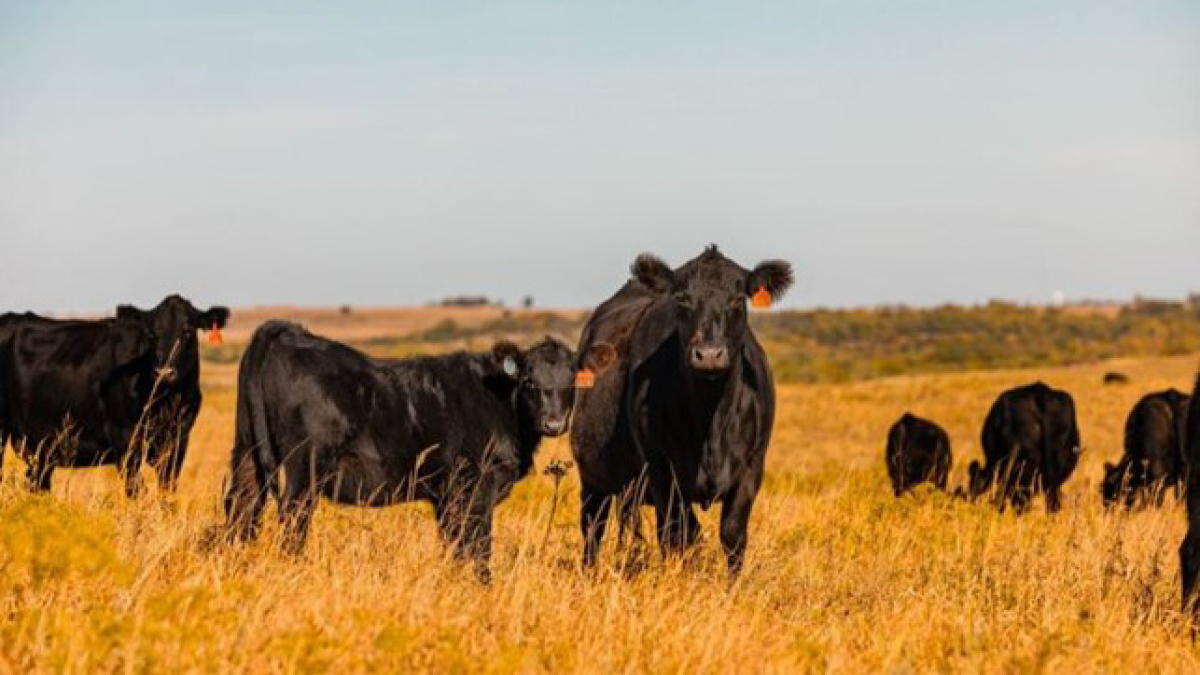
[LEXINGTON, Ky.] — Alltech, a global leader in animal nutrition and crop science, has launched Planet of Plenty, LLC, a new business entity dedicated to science-led storytelling, advocacy and educational initiatives that amplify agriculture’s vital role in creating a sustainable future.
This initiative builds on Alltech’s vision of Working Together for a Planet of Plenty®, which unites the agri-food community in creating a world where agriculture thrives, nutritious food is abundant and accessible, and our planet’s natural resources are replenished for generations to come.
While most families had ties to agriculture just two generations ago, many people today lack firsthand exposure to how the world’s food is produced. This disconnect can lead to misconceptions and oversimplified narratives about agriculture’s environmental impact, the role of farmers in creating climate solutions, and the complexity of feeding a growing population while protecting natural resources.
Through powerful storytelling, advocacy and educational initiatives, Planet of Plenty LLC aims to bridge that gap.
“Through Planet of Plenty LLC, we can take viewers on a global journey — into fields, research labs and farming communities — where they will see firsthand the intricate relationship between agriculture, the environment and food and economic security,” said Dr. Mark Lyons, president and CEO of Alltech.
Planet of Plenty LLC will serve as a collaborative hub where those within the agri-food community and beyond can:
Planet of Plenty LLC’s flagship project is World Without Cows, a feature-length documentary that amplifies the diverse perspectives of researchers studying methane emissions, farmers implementing regenerative practices, experts tackling the challenge of nourishing a growing population, and people in rural communities who rely on cows for their livelihoods. Co-created by two award-winning journalists who now work at Alltech, World Without Cows takes viewers on a global journey to foster a deeper understanding of everything cows contribute — and what the world might look like without them.
Over the past six months, World Without Cows has been screened at film festivals and events worldwide, sparking a broader discussion about the essential role of agriculture in sustainability, food security and the global economy.
Through collaboration with Alltech’s in-house media team and extensive global network, Planet of Plenty LLC will continue to create visually compelling, deeply informative content that accurately portrays modern agriculture’s complexities and opportunities — using science-based insights and storytelling to engage with audiences, just as World Without Cows has done around the world.
As interest in World Without Cows grows, this initiative offers supporters a mechanism to strengthen the documentary’s impact by opening doors to new audiences. Financial contributions to Planet of Plenty LLC will directly fund efforts to expand the documentary’s reach — and will also support additional science-based storytelling and advocacy initiatives that keep the conversation going.
“Agriculture’s most powerful stories are told by those on the frontlines,” Dr. Mark Lyons said. “Driving meaningful change begins with awareness, understanding and broader conversations, which Planet of Plenty LLC will endeavor to cultivate."
To learn more about World Without Cows and how to contribute to Planet of Plenty LLC, visit worldwithoutcows.com/contribute.
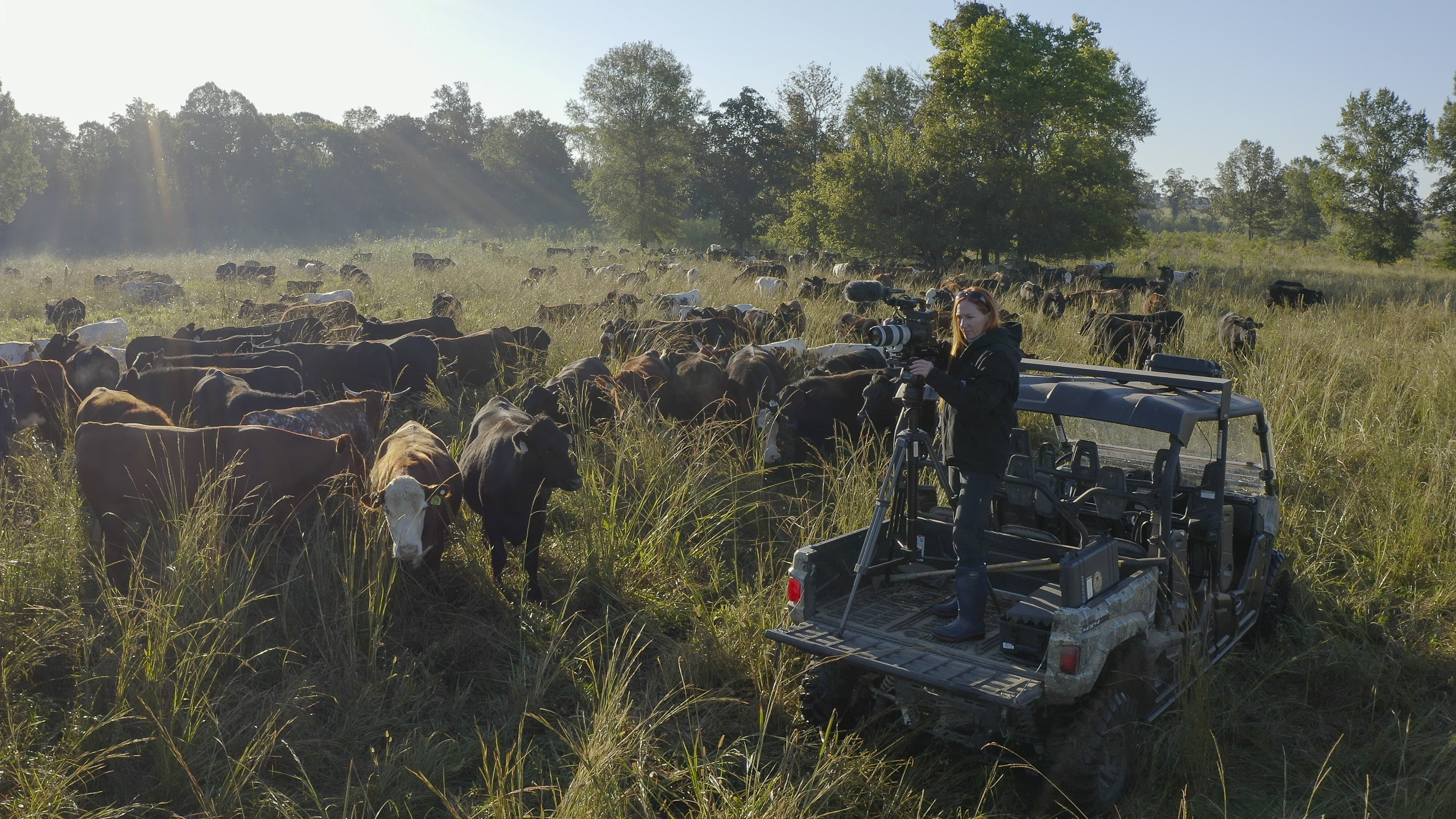
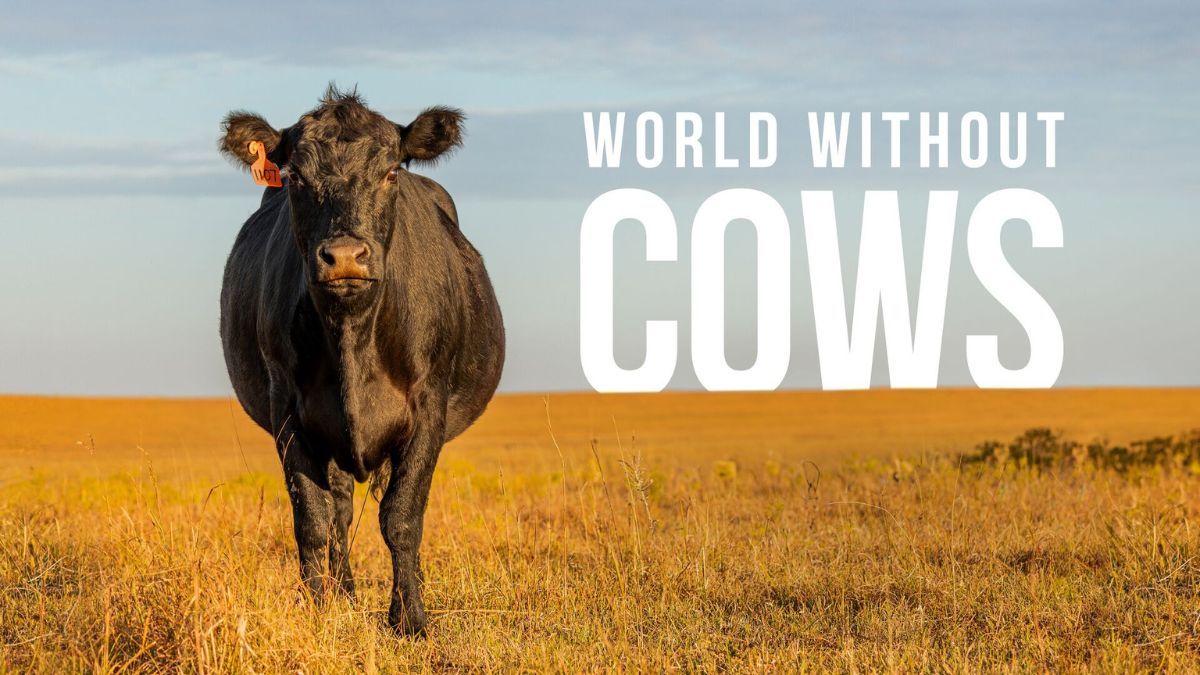
World Without Cows, a Planet of Plenty® production, is a feature-length documentary that examines the impact of cows on our world.
[LEXINGTON, Ky.] – Alltech has welcomed Jorge Noricumbo to the U.S. team as territory sales manager covering the south-central valley of California. He will also assist the Alltech Dairy On-Farm Support team with trainings.
Noricumbo is an advocate of training and delegating to succeed. Throughout his career, he has worked in collaboration with dairy farmers, consultants, veterinarians and nutritionists to help dairy farms improve the quality and efficiency of their processes. He focuses on training in many areas, such as maternity, calves, milking parlor, stockmanship and feed bunk management.
Born and raised in Mexico City, Noricumbo received a degree in Veterinary Medicine and Zootechnics from Universidad Nacional Autonoma de Mexico (UNAM), as well as a Master of Science in Animal Science from Massey University in New Zealand. He has worked in the dairy industry in Mexico and the U.S., primarily in California, Oregon and Washington, focusing on feed additives and pharmaceutical products in different roles as sales and technical support.
“We are pleased to welcome Jorge to the Alltech U.S. Dairy team in California, as his experience and knowledge will be a great asset to our customers,” said Caley Heiman, Alltech regional sales manager.
For more information about Alltech, visit alltech.com, and learn more about the Alltech Dairy On-Farm Support team at alltech.com/dairy-on-farm-support.

Jorge Noricumbo has joined the Alltech U.S. team as territory sales manager covering the south-central valley of California.
Using the feed data recorded with InTouch, we can accurately monitor a dairy farm’s performance with milk data input to create a ration performance monitor (RPM).
See below for how to manually input this information, which includes milk yield (total litres in the tank per day, plus any dump milk), cows in milk, the latest butterfat and protein results, and any feed not included in the mixer wagon, such as parlour or robot cake.
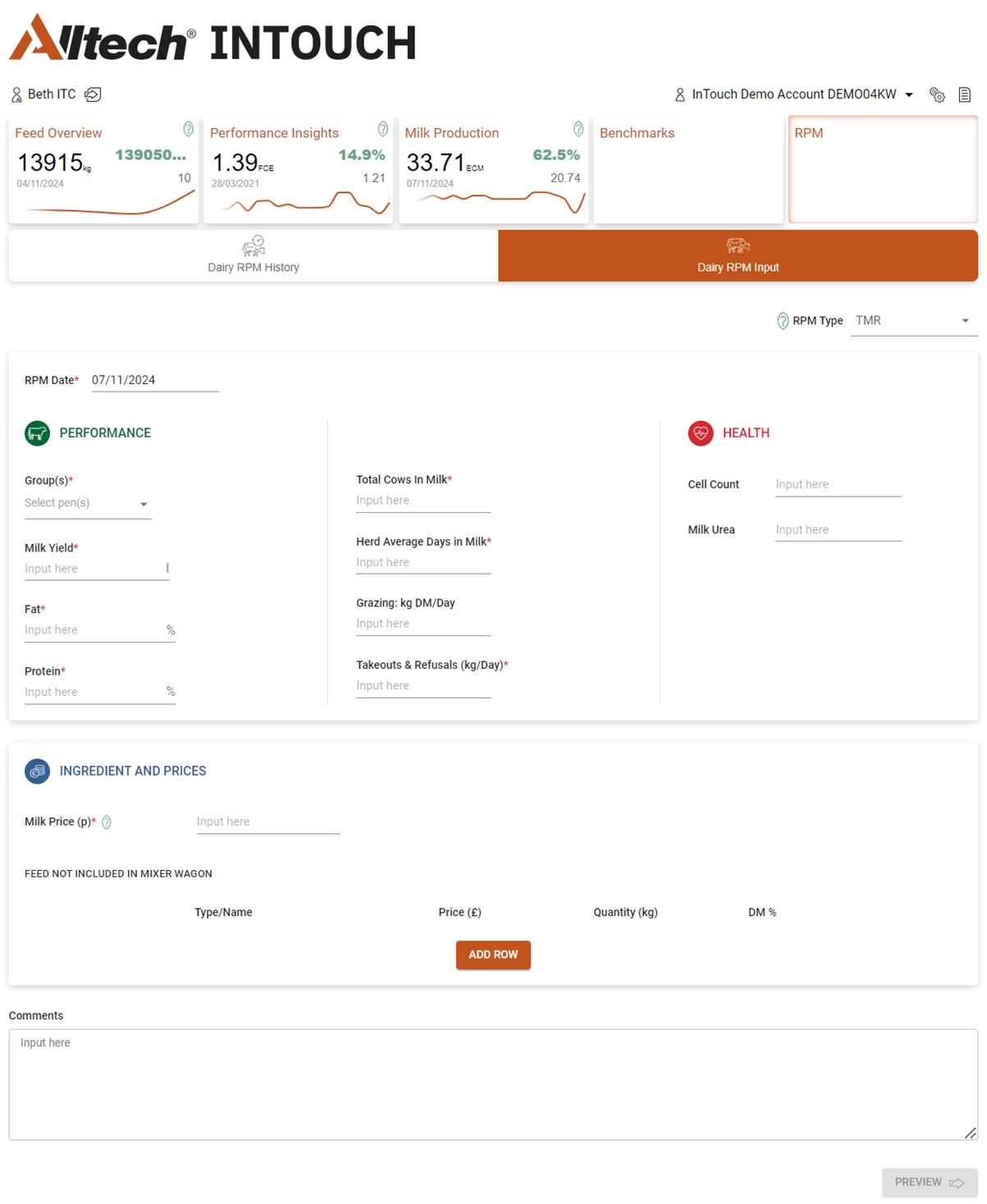
An RPM monitors the farm’s performance with any ration changes. Using the past three days of loading data, it then calculates each ingredient fed out on a per-head basis. This can be used in contrast to the ration formulated to, again, monitor the farm’s accuracy of loading.
Dry matter intake is calculated for animals based on the previous day's feed-out data to one or more pens, subtracting refusals. Refusals are calculated by either weighing back into the feeder wagon or estimating on the RPM form. Results from the RPM can then be accurately used to monitor what is actually being fed to animals in comparison to the formulated diet. Some factors that can affect dry matter intake include heat stress, spells of cold weather, mycotoxins and ration presentation.
All ingredient costs and DM% on the DTM must be up-to-date to ensure data is accurate and can be validated. The InTouch league table then allows benchmarking of figures alongside other InTouch users in the region. The table is ordered by feed conversion efficiency (FCE). A 0.1 improvement in FCE can reduce methane by 5% per litre of milk (Kebreab et al., 2003), making this a key target for profitability and meeting future requirements for reductions in methane emissions on-farm.
InTouch is also linked with UNIFORM-Agri and Dairy Data Warehouse to automatically receive the above data and create a weekly RPM. This, along with farmers manually inputting regularly, enables the nutritionist to remotely monitor the herd performance, allowing any necessary changes to be made or visits planned before herd output has reduced.
Read the previous blog article: Monitor loading accuracy with InTouch
InTouch Hub contact details
By phone: 0800 587 3297
By email: intouchsupportteam@alltech.com
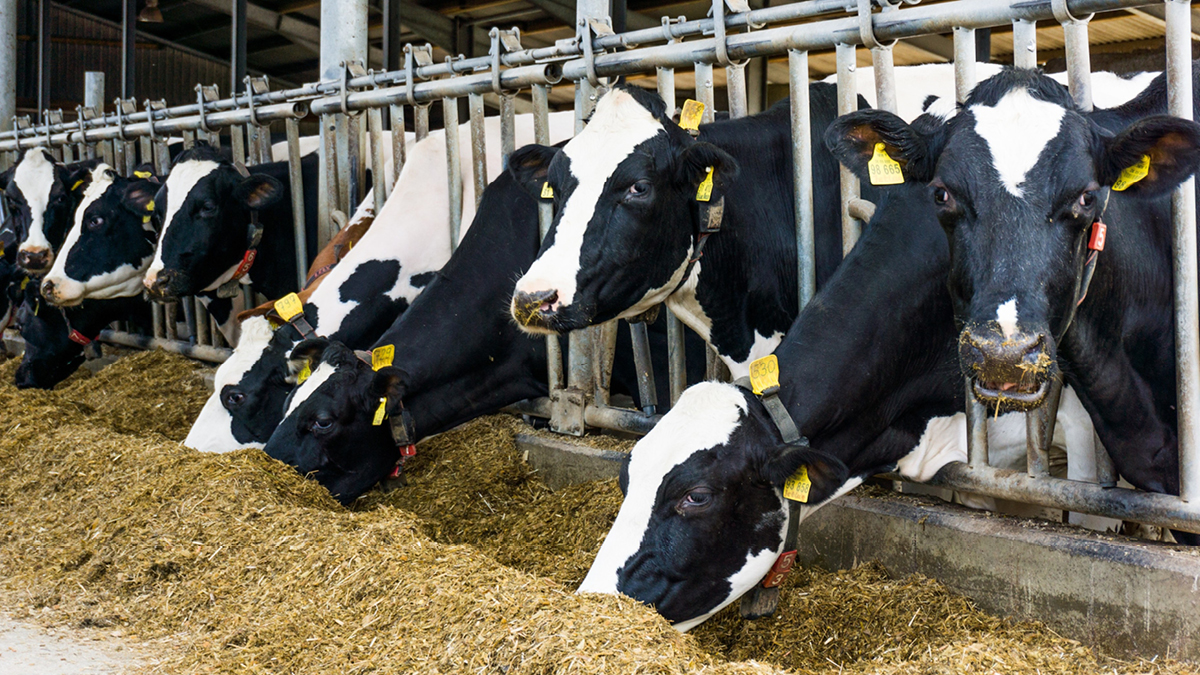
Feed can represent up to 70% of farm input cost, but usage is not always optimal, and wastage is a big problem.
The InTouch feed management system monitors loading accuracy and minimises the difference between the formulated ration and the ration consumed by the animal.
The InTouch toolkit, made up of:
the controller – which can be retrofitted to any diet feeder and guides the operator to load each ingredient accurately, in the right order and for the right number of animals.
the mobile app – which can be used as a second screen and operated remotely in the cab via mobile/tablet to improve vision during loading,
the online dashboard – which provides the feeding overview and production performance over time
a dedicated support team – with both on-farm feeding specialists and on-line InTouch hub service support
Further settings on the controller can also be enabled suited to each farm’s loading setup, such as ‘Auto-Next Source’, which uses a percentage or weight threshold set before switching to the next ingredient to avoid overloading.
Using the InTouch dashboard, individual loads can be monitored for the accuracy of each ingredient loaded.
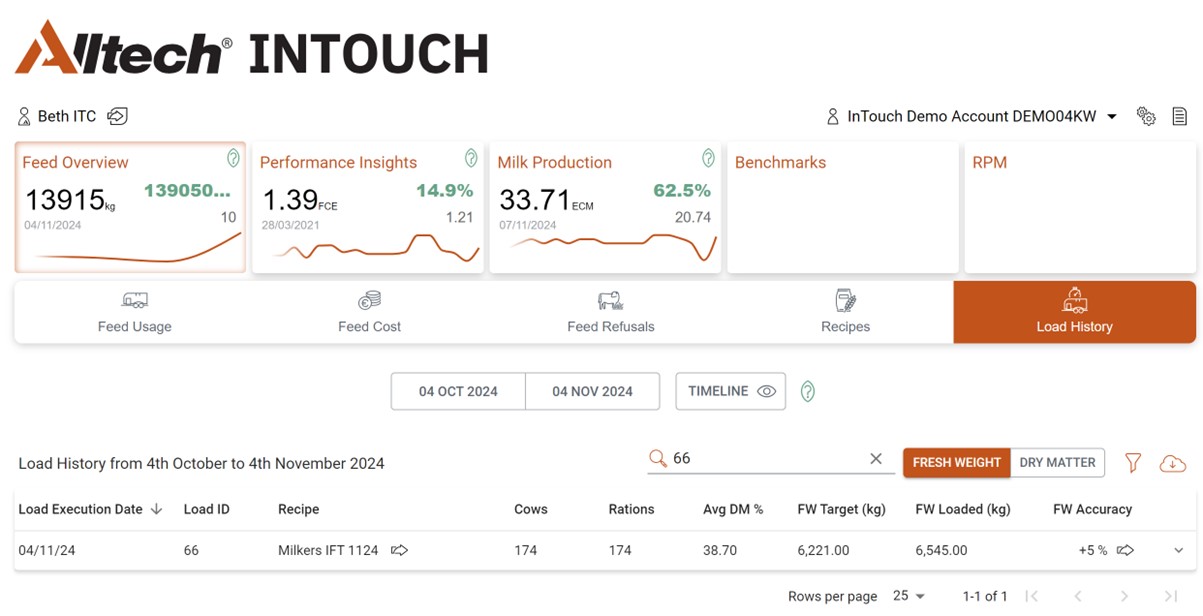
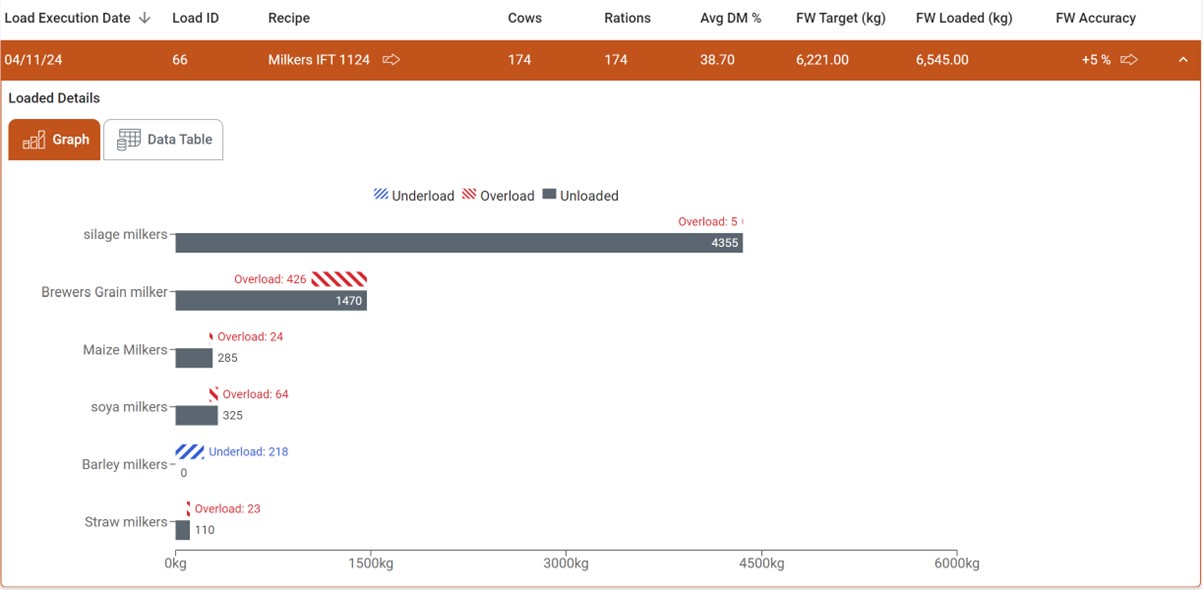
The type of feed being loaded into the wagon. Long fibres such as straw and stodgy ingredients such as brewers grains may be less accurate to load into the wagon. It is important to still try to load these as accurately as possible, but manage expectations with the farmer. Ingredients with a small total weight, such as minerals, must be weighed with hand scales prior to loading. To ensure the cost of these is recognised for each load, we can adjust the settings on the mobile app/desktop so they are identified as ‘Handheld’ ingredients. The ‘Handheld’ function still prompts the operator to load the required amount but will limit false inaccuracies in the reporting.
Changes in dry matter of feed stored in outdoor clamps, e.g. silages. Regularly monitoring the dry matter of these and updating the ingredient DM% will automatically update the fresh weight required in each ration.
Movement of the feeder wagon. We suggest loading concentrates earlier on in the mix for a MechFiber machine whilst the Power Take Off (PTO) is turned off, then turning the PTO on before adding forages. The ‘Pause’ function on the controller allows the operator to pause the weight before moving the machine if they are loading liquids such as molasses from a tank.
Ensuring that all weigh cells are functioning and the machine is calibrated. We recommend ringing InTouch Hub technical support to check that weigh cells are all working. This includes calibrating the scale with a known weight.
Being an associated nutritionist on a farm’s account provides you with weekly accuracy reports direct to your email. Please contact the InTouch support team to receive the forms to do this.
Read the next blog article: Monitor herd performance day to day with InTouch dairy RPM
InTouch Hub contact details
By phone: 0800 587 3297
By email: intouchsupportteam@alltech.com

Agricultural technology (ag-tech) is becoming increasingly essential to adopt on-farm. Its benefits are multifaceted: It enables higher yields with fewer resources, enhances health and welfare standards, and provides greater transparency throughout the supply chain.
The reluctance to embrace agricultural technology, however, is still relatively strong across the farming sector, with fear, scepticism, and/or a preference for simplicity somewhat outdoing the appeal.
But with time and developments, confidence has grown, abilities have developed, incentives have enticed, and margins have forced the adoption of ag-tech.
According to the Future of Agri-Tech Report 2024, over half of businesses in the UK food industry say adopting new technologies is a key business priority in the next five years. And we should expect a ripple effect to farm level.
Beef production technology areas include:
Feed production, such as GPS and alternative proteins
Feed management, such as consumption monitors and feed bin sensors
Genetics and breeding, such as genomic analysis and selection
Handling and identification, such as herd management apps
Health, such as ear tag monitors and machine learning for lameness
Feed is frequently cited as accounting for over half of the total cost in beef production, with prices that can fluctuate rapidly and significantly. Given this, feeding technology stands out as one of the most critical areas of ag-tech to adopt.
For cattle raised on a forage-based diet or a total mixed ration (TMR), feeding technologies like Alltech InTouch offer valuable opportunities to enhance herd health, improve farm efficiency and boost profit margins.
Alltech InTouch is a pioneering digital feed management toolkit that keeps farmers in control of feed conversion efficiency, margin from feed, and all-round farm sustainability. The InTouch toolkit is made up of a control unit, a mobile app, and an online dashboard, all driven and supported by a specialist on-farm and remote team missioned to work with farm teams to improve feeding accuracy and optimise TMR performance.
Alltech InTouch equips farmers with these capabilities:
Managing income over feed cost (IOFC) through precision feeding, tracking of feed intakes, management of feed costs, and linking of feed inputs with yield outputs
Ensuring precision and consistency in cow feeding through clearly directing the precise loading and feed-out of each ration with correct loading amounts, loading orders and mixing times, no matter who the operator
Monitoring and planning feed inventory through monitoring quantities of feed consumed against feed stocks held on-farm; and, depending on the system, automatic alerts when stocks require replenishing
Reporting and collaboration through the real-time logging of feeding information and performance data that is remotely accessible to all stakeholders in the form of easy-to-digest graphs and tables
Reformulating diets from anywhere, by either the on-farm decision-makers or third-party nutritional advisors, to quickly and easily reflect any changes in intakes and changes in groups (e.g., if stock get pulled out for killing)
At the core of the system is a state-of-the-art control screen that can be hardwired into the weigh cells of any diet feeder. This practical and functional setup provides a clear, real-time display of feed weight as the feeder is being loaded, unlike more basic transmitters that only send data to a tablet in the cab.
Two progressive beef farmers in Lincolnshire who contract-finish for two leading beef suppliers offer an unvarnished review on the Alltech InTouch system after months of putting the technology to the test.
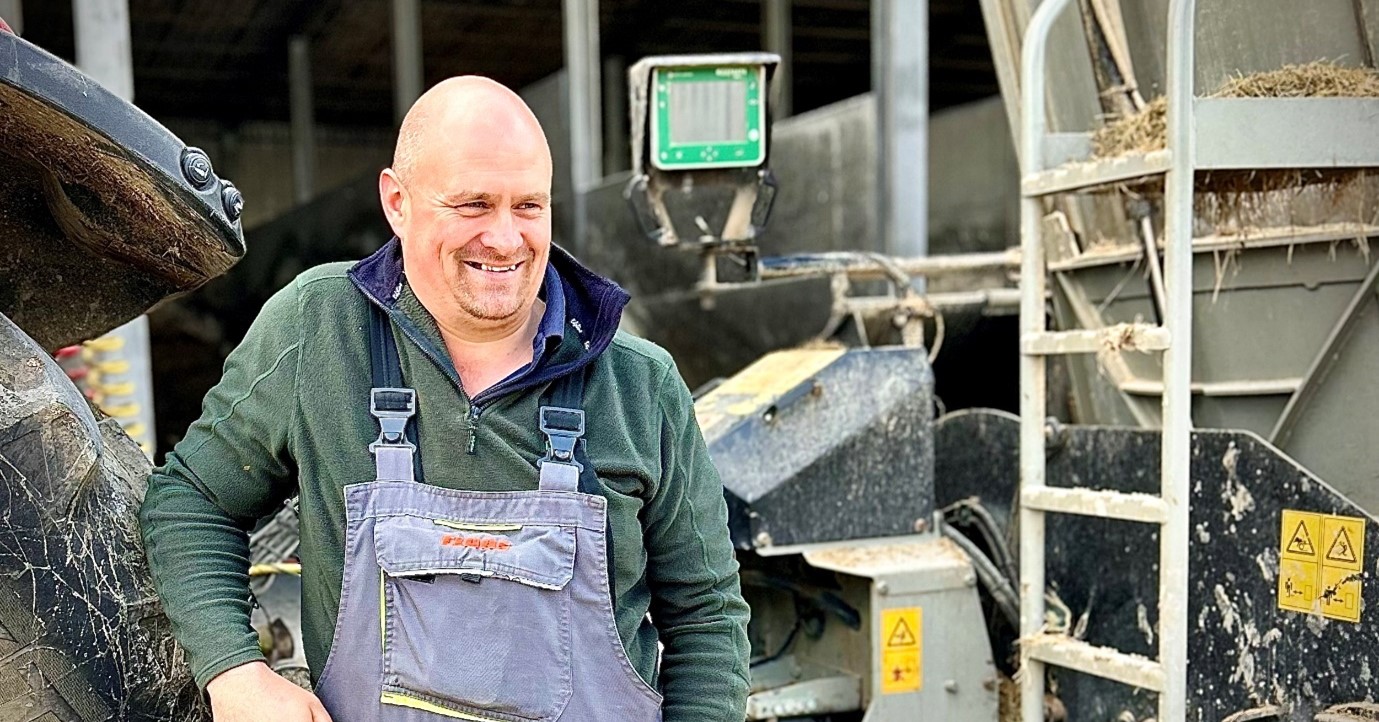
Pictured: Matt Underwood, Farm Manager
Founded over four generations ago, Laughtons of Louth in Lincolnshire contract-finishes up to 3,000 animals annually as part of an integrated program.
The operation is managed daily by Andrew Laughton, National Beef Association board member and recipient of the 2018 Beef Farmer of the Year award, alongside herd manager Matt Underwood.
With five farmhands doing the feeding, the farm required a simple, flexible and infallible way of loading the diet feeder. Incentivised by integrated genetics and customer requirements, the management team decided to ditch their old weigh scales for the more technologically advanced Alltech InTouch system.
The first technical support visit confirmed its benefits but also revealed some technical challenges, which were worked through on the visit.
“InTouch has made precision feeding more achievable. We are now running at a DLWG of 1.2 kg from calf to finish. Before, we had to come into the office to do any diet changes. Now we can do it all in the yard,” Andrew said.
“I always look at the report for accuracy at the interface and feed usage over time,” Matt said. “I like it for how easy it is to set up. It does make feed management a lot quicker.”
“One of my irritations with feeding cattle is that it’s too fast-moving to have set groups,” Andrew said. “We’re always moving cattle — maybe putting new ones in, taking out fat cattle, or splitting out the steers. Feeding per head means that you got to know exactly how many cattle.
“It sounds very easy, but in practice, it’s not. So, if you’re trying to address individual requirements and then numbers per group on top, accuracy in practice can drift.”
During the visit, the InTouch technical support team established an alternative way of managing ration changes, shifting from a per-head basis to a percentage basis. This means formulating a 1-tonne ration to a set specification, which is regarded as 100%. If a group changes in any way, you can then easily work out a percentage of that set ration to feed to a particular pen. Alltech InTouch was able to accommodate this within days through a flexible approach to how diets can be interpreted, working with on-farm support to tailor this to suit individual farm/cattle group size requirements.
Also on the visit, the controller count speed was modified to accommodate a quicker operator speed, ensuring the controller counter keeps up with the pace of loading.
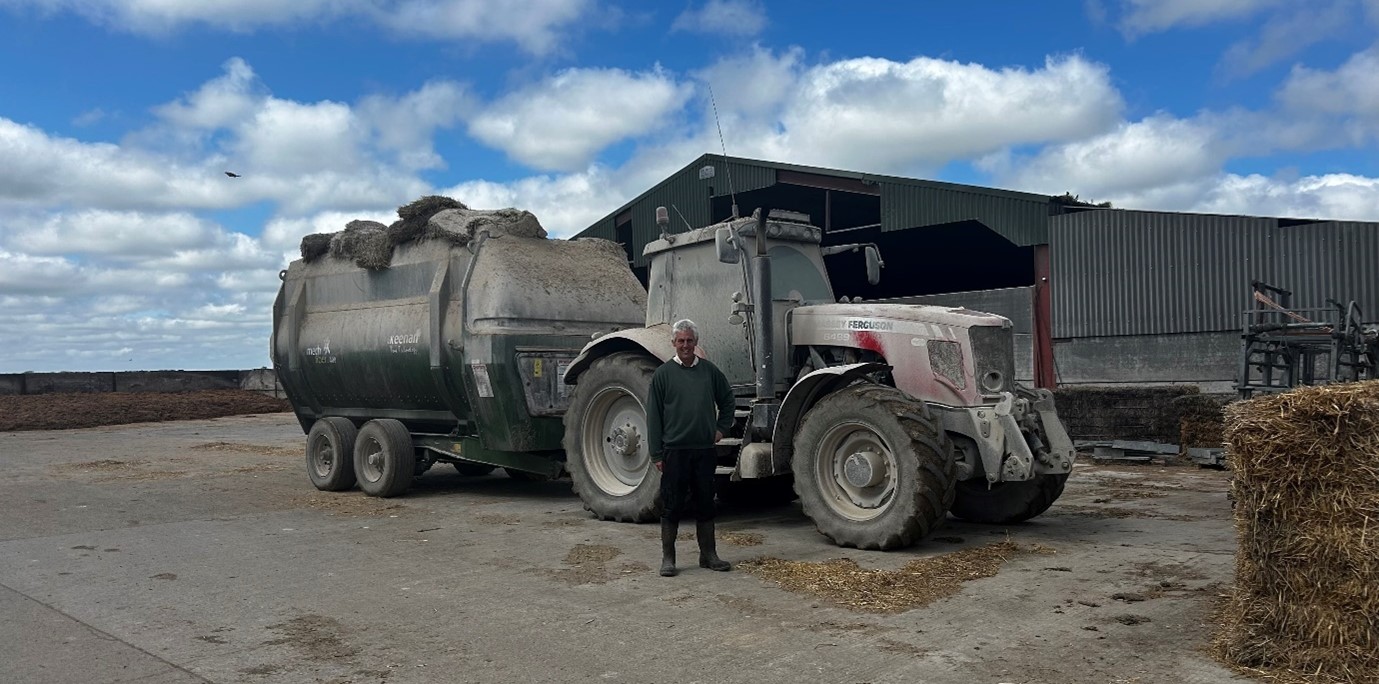
Pictured: Gary Allis
The Allis family have been in the business of producing beef at Furze Farm for 25 years, finishing 4,000–5,000 cattle on a bed-and-breakfast arrangement with Buitelaar every year.
Gary and Charles, the father-and-son duo who run the farm, have accomplished a low-cost but well-balanced diet under the firm belief that profitability is totally dependent on the price of feed and achieving good feed conversion rates. As a testament to their skill and success, they were finalists for Beef Farmer of the Year in 2015.
“Keeping cattle is all about feeding,” Gary said. “Feed conversion is the be-all and end-all. We’re about buying feed right and getting the diet right. Feed can go wrong so fast, so we buy through and never leave ourselves in position where we have to buy feed.
“Carbon is going to be more and more important as we go forward, and it’s about having the right figures. To me, it’s quite simple: The less days something is on the farm, the less it’s polluting.
“We’ve had the KEENAN MechFiber400 diet feeder for four years, doing four mixes a day. It was actually by accident that we got a KEENAN. We have a very high dry matter mix and couldn’t get the straw to mix on our old Shelbourne Reynolds system. We broke down and borrowed an old KEENAN 140 Klassik and couldn’t believe how quick it was. We now feed in an hour, easily. The machine had PACE, which was good, but we put the fourth-generation InTouch controller on to make feeding more accurate. It’ll weigh immediately and stops us putting extra in of the expensive materials like distillers.
“Diets have to be flexible, and InTouch makes it work. We use mainly by-products, including a moist blend, maize meal, biscuit meal, soya hull and barley. If anything is more expensive, we need to be able to quickly reformulate. Cattle need feed all the time, and the troughs need emptying twice a day – it’s a fine line. Anyone can get on it and follow the plan.
“Charles has a group of growing cattle that we have had from 12-week-old calves that are gaining 1.3 kg of liveweight gain every day on ad-lib feeding. From weaning to finish, we’re working on about 2.5 tonnes of dry matter, which is about 2.3% a day. We’re aiming for 280 deadweight on these. This is because we have ultimate control over their feed and management from a young age, meaning we have a greater influence on their overall performance. The stores in the integrated finishing system require much more feed and are getting around 1.6 kg daily liveweight gain, depending on what comes in and the level of compensatory growth.”
With help from the team and technology behind KEENAN and InTouch, farmers such as Andrew, Matt, Gary and Charles can continue to see exceptional efficiency and profitability moving forward.
Visit the Alltech InTouch page for more information, alternatively, contact your local InTouch specialist.
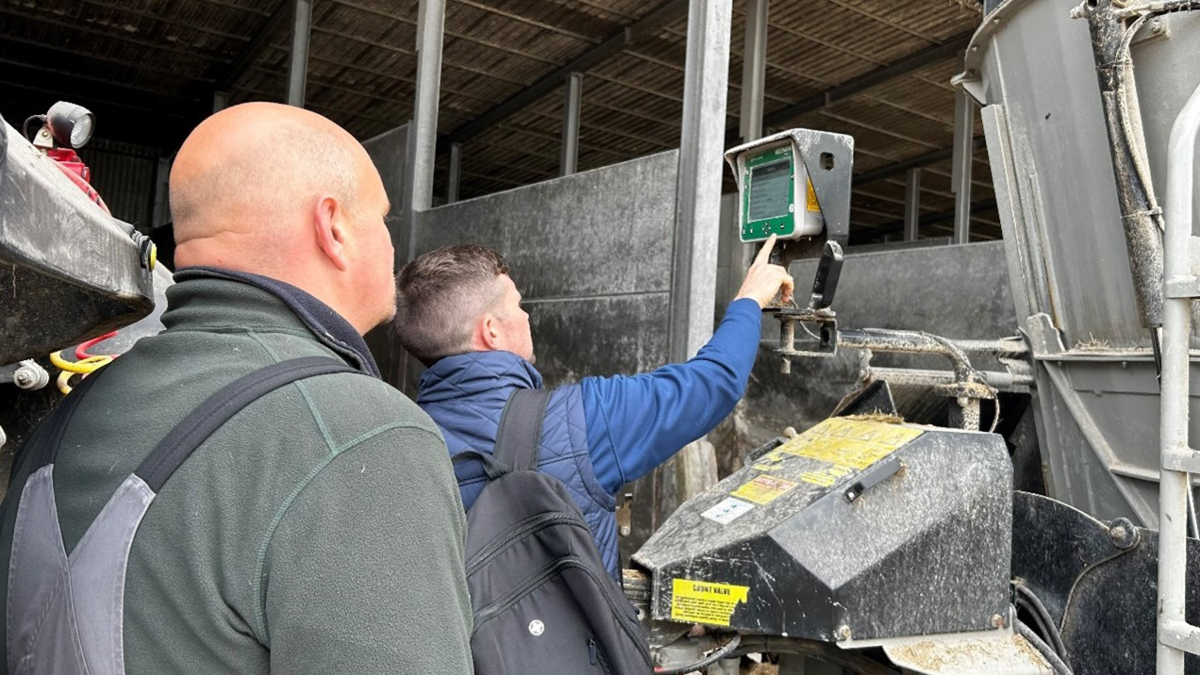
La resistencia a los antimicrobianos (RAM) representa un desafío importante a la hora de encontrar y aplicar nuevos tratamientos antibióticos contra las bacterias. La creciente amenaza de las infecciones farmacorresistentes incrementa este desafío, por lo que es clave que la industria agropecuaria reduzca su contribución a la RAM.
El pollo y los huevos –al ser alimentos versátiles y ricos en proteínas– son productos básicos en muchos hogares, lo que hace que las aves comerciales sean una de las carnes más consumidas en todo el mundo. Para el año 2032 se espera que su consumo total alcance los 100 millones de toneladas. No obstante, el pollo y los huevos crudos pueden albergar patógenos como Campylobacter, Salmonella y Clostridium perfringens que causan enfermedades transmitidas por alimentos. Estas bacterias pueden contaminar los alimentos durante la faena y el procesamiento; lo que supone una gran amenaza para la salud pública.
Tradicionalmente se han utilizado los antimicrobianos para hacer frente a estos patógenos. Sin embargo, el uso incorrecto o excesivo de esta tecnología ha favorecido el desarrollo de la RAM. Y las bacterias resistentes –y los genes que causan esa resistencia– pueden propagarse de los alimentos de origen animal a los seres humanos a través de la cadena alimentaria.
La RAM es una de las diez principales amenazas para la salud mundial: asociada a 4.95 millones de muertes anuales (cifra que podría aumentar en 2050 a 10 millones al año). La RAM también supone una carga económica para los sistemas sanitarios: con un costo anual de 180 millones de libras (229 millones de dólares) para el Servicio Nacional de Salud del Reino Unido y de 55 000 millones de dólares para los Estados Unidos (20 000 millones por asistencia sanitaria y 35 000 millones por pérdida de productividad).
El mayor conocimiento de la RAM ha llevado a que muchos países prohíban la inclusión de los antibióticos como promotores de crecimiento en las dietas de los animales. Pero a pesar de estas prohibiciones, las tasas de resistencia siguen siendo elevadas. Por ejemplo, el último informe de la Unión Europea (2021-22) destaca que las bacterias que se encontraron en pollos, pavos y gallinas ponedoras son muy resistentes a un tipo de antibiótico de uso común llamado fluoroquinolonas.
Es clave adoptar un enfoque integral para abordar la RAM en la producción avícola. Este enfoque debe incluir:
Las alternativas a los antibióticos están enfocadas en mejorar la salud intestinal y el microbioma de las aves. En este sentido, la fracción rica en manano –derivada de las paredes celulares de la levadura– favorece la salud y el desempeño animal al modular el microbioma, adsorber las bacterias patógenas y apoyar la salud intestinal.
Investigaciones recientes demuestran efectos positivos de la fracción rica en manano sobre la susceptibilidad bacteriana a los antibióticos. Los estudios de Smith et al., 2017; 2020 y 2022 indican que la fracción rica en manano reduce el crecimiento de la resistencia a los antibióticos para E. coli en un 46% y en un 73% cuando se proporciona junto con antibióticos como la ampicilina. Esto se debe a que la fracción rica en manano apoya determinadas proteínas que participan en el proceso de producción de energía y aumenta la producción de especies reactivas del oxígeno (ROS) perjudiciales para las bacterias. Estas alteraciones conducen a una eliminación más eficaz de las bacterias y a un cambio en la forma en que estas bacterias responden a los antibióticos.
Ya que el pollo y los huevos son alimentos básicos para muchas familias es muy importante garantizar la inocuidad de estos productos avícolas. En este sentido, reducir los agentes patógenos –como Salmonella, Campylobacter o E. coli– que se transmiten por los alimentos puede disminuir la mortalidad, aliviar la carga económica y reducir la propagación de la RAM desde la industria agropecuaria a la sociedad.
Adoptar un enfoque eficaz y holístico para la seguridad alimentaria desde la avicultura es clave. Y soluciones innovadoras como la fracción rica en manano ayudan a reducir la prevalencia de las bacterias resistentes; haciendo menos necesario el uso de antibióticos y apoyando su eficacia cuando son necesarios. Este enfoque ayuda a la industria agropecuaria a mitigar su contribución a la RAM, protegiendo así la salud pública.
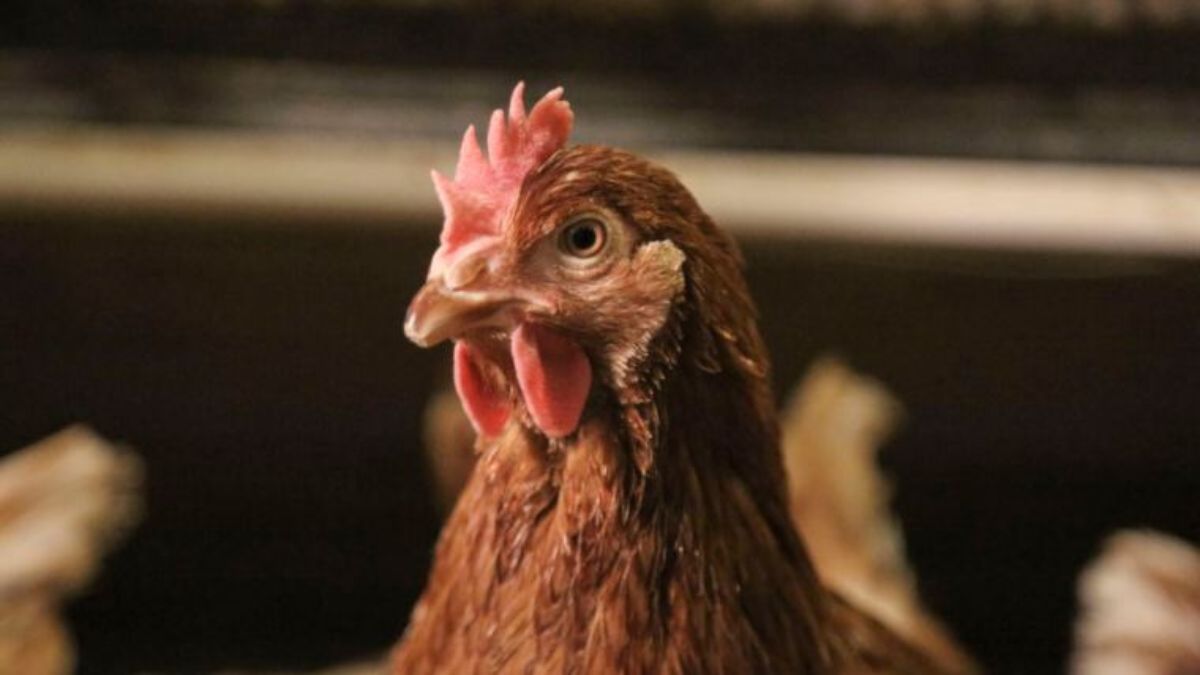
İneklerin dünyamız üzerindeki çok yönlü ve çoğu zaman şaşırtıcı etkilerini inceleyen yeni bir belgesel olan "World Without Cows” (İneklerin Olmadığı Bir Dünya)"ın resmi lansmanı geçtiğimiz yılın sonlarında yapıldı ve bir çok ülkede gösterimine başlandı. Belgesel, tarım ve çevre bilimlerinin en ön sıralarında yer alan kişilerle yapılan röportajlar aracılığıyla, sığırların kültürel ve ekonomik önemini, dünyayı beslemedeki rollerini ve iklim üzerindeki etkilerini araştırıyor.
Sığırlarla ilgili yaygın ve bilimsel temeli olmayan bazı olumsuz anlatılardan da ilham alan bu ilgi çekici yapım, tarım hakkında hikayeler anlatan iki gazeteci Michelle Michael ve Brandon Whitworth tarafından yönetildi.
Michelle ve Brandon, üç yıl önce, Amerikan kırsalından Kenya, Hindistan, Brezilya ve ötesine uzanan 40'tan fazla ülkeyi seyahat ettikleri bir maceraya atıldı ve basit gibi görünen bir soruyu yanıtlamaya çalıştı: "İneklerin olmadığı bir dünyada daha iyi bir durumda mı olurduk?" İkili, tüm bu süre boyunca, tarım ve çevre bilimcileri, çiftçiler, yetiştiriciler, akademisyenler ve diğer uzmanlarla global bağlantılar kurarak, ineklerin dünyamız üzerindeki etkilerini ve yok olmalarının potansiyel sonuçlarını yakından gözlemlediler. Karşılaştıkları sonuçlar basit değildi: İnekler söz konusu olduğunda her şeyi sadece siyah ya da sadece beyaz olarak ele almamız mümkün görünmüyordu. İnsanlığın sığırlara olan bağımlılığı, düşünüldüğünden çok daha karmaşıktı ve hem global hem de yerel düzeyde ineklerin insanların ve gezegenin gelişmesine nasıl katkı sağladığına dair tartışmalar da böyleydi.
“Bu hikayeyi bizim anlatacağımızı hiç düşünmemiştim” diyor Whitworth. “Ama öğrendiklerimiz çoğaldıkça, sanki başka bir seçeneğimiz yokmuş gibi hissettik.” diye ekliyor Michael. “Bir sorumluluğumuz vardı. Bu hikayeyi anlatmak zorundaydık. Dünyanın dört bir yanında çiftçiler bize kapılarını açtılar.”
“Dünyanın dört bir yanından onlarca insanla konuştuk - çeşitli alanlarda birçok farklı uzmanla,” diye devam ediyor Whitworth. “Ve şu soruyu sorduk: İneklerin olmadığı bir dünya nasıl görünürdü?”
Ortaya çıkan belgesel, sığırların kültürel, sosyal, ekonomik, beslenme ve çevresel açılardan etkilerini inceleyen çeşitli uzmanları bir araya getiriyor. Bilim odaklı bu tartışma, dünyanın birçok bölgesinde sığırlara olan derin bağlılığı, hızla artan global nüfusu besleme zorluklarını, hayvansal proteinin temel değerini ve sığırlarla çevre arasındaki ilişkinin altını çiziyor. Sığırların biyolojik çeşitlilik, toprak sağlığı ve karbon yakalama üzerindeki etkileri de bu hikayede ele alınıyor.
85 dakikalık belgesel, sığırların dünyamızı nasıl etkilediği konusunda tartışmayı genişletmeyi amaçlıyor ve izleyicileri, sığırların gezegenimizin geleceği üzerindeki rolü hakkında daha derin düşünmeye teşvik ediyor. Böylece, sığırlarla ilgili göz önünde bulundurulması gereken çok sayıdaki unsuru keşfetmeye davet ediyor.
Whitworth, bu belgeselin herkesin kendi düşüncesini dile getirdiği bir diyalog olmadığını belirtiyor. “Bu kişiler doktorlar, doktoralı uzmanlar, çiftçiler, yetiştiriciler; tüm bu alanlarda doğrudan deneyim ve bilgi sahibi insanlar. Bu düşünceler gerçekleri ve bilimi esas alıyor.”
Michael ve Whitworth'un danıştığı uzmanlardan biri, University of Nottingham'da Gıda Sistemleri Enstitüsü direktörü ve gıda gelecekbilimcisi Jack Bobo. Bobo, 10.000 yıldır, çiftçilerden ve yetiştiricilerden istenen tek şeyin daha fazla gıda üretmeleri olduğunu söylüyor. “Her 11-12 yılda, nüfusumuza bir milyar insan ekleniyor. Zorluk şu ki, bugünden 2050'ye kadar her gün dünyayı beslemek daha da zorlaşıyor.”
Rabobank'ta global stratejist olan Justin Sherrard, dünya genelinde yaklaşık her 10 kişiden 1'inin, yani 800 milyondan fazla insanın, geçimini doğrudan sığırlara bağlı olarak sağladığını ve bu nedenle, global gıda sisteminin her bir parçasıyla ilgilenmemiz gerektiğini söylüyor.
University of Oxford'tan iklim bilimci Dr. John Lynch, sera gazı emisyonlarının azaltılmasının acil bir ihtiyaç olduğunu belirtiyor. Lynch, “Eğer gezegeni ısıtmaya devam eder ve bu aşırı olayların daha sık meydana gelmesine neden olursak, dünya 30 veya 40 yıl içinde nasıl görünecek?” diye soruyor. “Bence bir anket yaptığımızda, birçok kişi, ‘Evet, inekler iklim için dünyadaki en kötü şeydir.’ der. Oysa, iklim değişikliğine en büyük olumsuz katkıyı yapanlar inekler değildir, fosil yakıtlardır.”
California Üniversitesi, Davis'teki CLEAR Center'ın direktörü ve hava kalitesi uzmanı olan profesör Dr. Frank Mitloehner, global arazi kullanım durumu, sera gazı emisyonları ve sığırların iklim üzerindeki etkilerini ele alıyor. “Hayvan yetiştiriciliğinin hiçbir etkisi yoktur ya da etkisi çok küçüktür diyecek değilim. Toplumun her bir parçası gibi, hayvancılığın da üzerine düşeni yapması ve iklim üzerindeki etkimizi azaltmaya yardımcı olması gerekiyor. Bunu yapabiliriz ve yapmalıyız. Ancak bu hayvanların, emisyonların çoğundan sorumlu olduğu hikayelerini uydurmamalıyız. Onlar, emisyonların çoğundan sorumlu değiller.”
World Without Cows hakkında
World Without Cows - “İneklerin Olmadığı Bir Dünya”, bir Planet of Plenty® prodüksiyonudur. Temellleri, dünyamızdaki tüm canlılara yeten bir gezegen yaratma amacıyla Dr. Mark Lyons tarafından 2019 yılında atılmıştır. Dr. Mark Lyons, global hayvan beslenmesi alanında faaliyet gösteren Alltech'in başkanı ve CEO'sudur.
Planet of Plenty, tarımın herkes için beslenme sağlamasına, kırsal toplulukları canlandırmasına ve gezegenin doğal kaynaklarını yenilemesine yardımcı olan bilim temelli çözümler oluşturmak ve benimsemek üzere, endüstriler ve coğrafyalar arasında iş birliğine çağrıda bulunan bir girişimdir.
Daha fazla bilgi almak, resmi fragmanı görüntülemek, filmle ilgili güncellemeler için kaydolmak ve sığırların hayatımız, geçim kaynağımız ve gezegenimiz hakkındaki bağlantısına dair daha fazla şey öğrenmek için worldwithoutcows.com adresini ziyaret edebilirsiniz. Web sitemiz, “İneklerin Olmadığı Bir Dünya”ya dair konuların daha derin bir incelemesini sunuyor. Bu belgeseli sığırlar hakkında daha geniş, bilim temelli tartışmalar yapılabilmesi için teşvik edici bir harekete dönüştürmeyi amaçlıyoruz ve web sitemiz, destek olma fırsatları ve kaynakları da içeriyor.
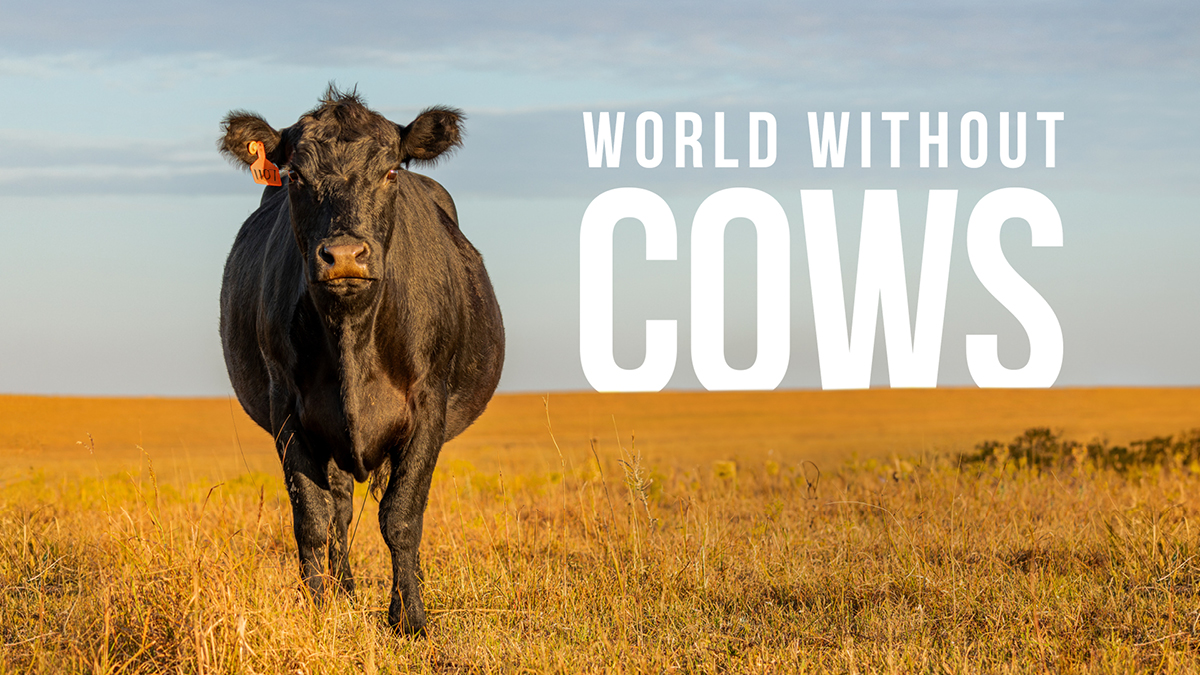
World Without Cows -İneklerin olmadığı bir dünya-, üç yıl boyunca 40’tan fazla lokasyonda çekildi. 85 dakikalık bu uzun metrajlı belgesel, sığırların ekonomiler, ekosistemler, kültürler ve insan beslenmesi üzerindeki etkilerini ele almaktadır.
Dr. Sebastian Mejia Turcios, on-farm support beef specialist for Alltech, joins us from CattleCon 2025 to talk about the importance of sustainability to the environment and animal well-being.
Benefícios do micromineral tanto para produção animal quanto para qualidade da proteína que chega à mesa do consumidor serão destacados pela Alltech no Show Rural 2025
A ciência comprova que uma dieta com microminerais orgânicos contribui não apenas para a saúde e o desempenho dos animais de produção, mas também impacta positivamente a durabilidade, as características sensoriais e a qualidade nutricional das proteínas que chegam à mesa do consumidor (carnes, leite e ovos).
“A evolução da nutrição animal responde à necessidade da eficiência ao mesmo tempo em que avançamos na produção de alimentos seguros, com alto valor nutricional e sustentáveis”, aponta a doutora em Nutrição Animal Adriana Nascimento, gerente técnica da Alltech para a América Latina. Segundo ela, essas exigências por parte dos consumidores continuarão a crescer. “Os microminerais orgânicos da Alltech mudaram a regra do jogo por serem mais biodisponíveis, ou seja, facilmente absorvidos e aproveitados pelos animais; consequentemente, potencializam os benefícios para o desempenho animal e para os produtos que chegam à mesa do consumidor”, observa.
Resultados do campo à mesa
De acordo com a especialista, um dos principais ganhos para o consumidor é ter carnes de maior qualidade em diversos parâmetros, como frescor, cor e tempo de prateleira (shelf life), e redução das perdas por gotejamento (drip loss). Conforme estudo da Universidade de Cambridge, frangos que receberam Sel-Plex™ na sua dieta, levedura enriquecida com selênio da Alltech, apresentaram melhor conversão alimentar, maior rendimento de peito e menor perda de umidade e oxidação da carne, o que resulta em produtos mais suculentos e duradouros.
Além disso, já começou a ser utilizada a suplementação animal com a forma orgânica do selênio como estratégia para a produção de alimentos com maior teor desse mineral, que contribui para o fortalecimento do sistema imunológico, a redução do risco de doenças degenerativas e a melhora da saúde reprodutiva de humanos.
Um estudo do Instituto de Ciência Animal da República Checa concluiu que a suplementação com Sel-Plex, em comparação com fontes inorgânicas, resultou em ovos e carne de frango com teor mais elevado de vitamina E e selênio. “Como o selênio é precursor da enzima antioxidante glutationa peroxidase, é provável que os maiores níveis de vitamina E resultem da menor demanda dessa vitamina, que também exerce função antioxidante”, comenta a especialista.
Particularidades dos animais aquáticos
A piscicultura enfrenta um desafio particular em relação aos metais pesados, muitas vezes associados a fontes minerais não seguras. “Como eles não são metabolizados, uma vez absorvidos pelos peixes, esses metais permanecem no filé e podem gerar disfunções no organismo humano”, afirma a doutora em Aquicultura Carolina Farias, gerente de vendas da Alltech. “Um diferencial da Alltech é o respaldo de certificações como a FamiQS e do seu rigoroso sistema de aprovação de matérias-primas para nossa linha de minerais”, cita.
Estudo conduzido pela Universidade Estadual de Ponta Grossa revelou que o uso do Sel-Plex em conjunto com minerais proteinatos da Alltech (Bioplex) demonstrou redução dos minerais excretados pelos peixes, principalmente zinco e cobre, considerados os principais poluentes encontrados em ambientes de criação de peixes, o que contribui para uma aquicultura mais sustentável. A pesquisa também indicou que o uso da levedura enriquecida com selênio se mostrou promissor para enriquecimento nutricional de filé - na comparação com peixes que receberam a ração com minerais inorgânicos. Este trabalho destacou ainda os benefícios do selênio para um maior tempo de prateleira do pescado e para a saúde do consumidor.
Pesquisas mostram que uma dieta rica em selênio auxilia na prevenção de doenças como câncer e Alzheimer. Estudo da Universidade de Auckland, na Nova Zelândia, indicou que a suplementação de selênio em homens saudáveis aumentou os níveis de selênio no soro e a atividade de enzimas antioxidantes. Isso contribuiu para a redução do estresse oxidativo e da instabilidade genômica, fatores associados ao desenvolvimento de doenças crônicas, como câncer e problemas cardiovasculares.
Show Rural 2025
Os benefícios da suplementação animal com microminerais orgânicos da Alltech para o setor agroalimentar serão destacados pela empresa no Show Rural Coopavel 2025, de 10 a 14 de fevereiro, em Cascavel (PR). Além do estande localizado no pavilhão 4, nos números 545 e 546, onde os visitantes da feira poderão conhecer todo o portfólio da empresa e esclarecer dúvidas, especialistas da Alltech também estarão na programação do Espaço Impulso. Na quarta-feira (12), às 15h30, Carolina Farias participará do painel “Nutritalk: nutrição do campo à mesa”, que também contará com representantes da Coopavel, FAG e Instituto Medicina Saúde e Nutrição. E na quinta-feira (13), às 14h, Adriana Nascimento ministrará a palestra “Biotecnologias nutricionais na produção avícola”.
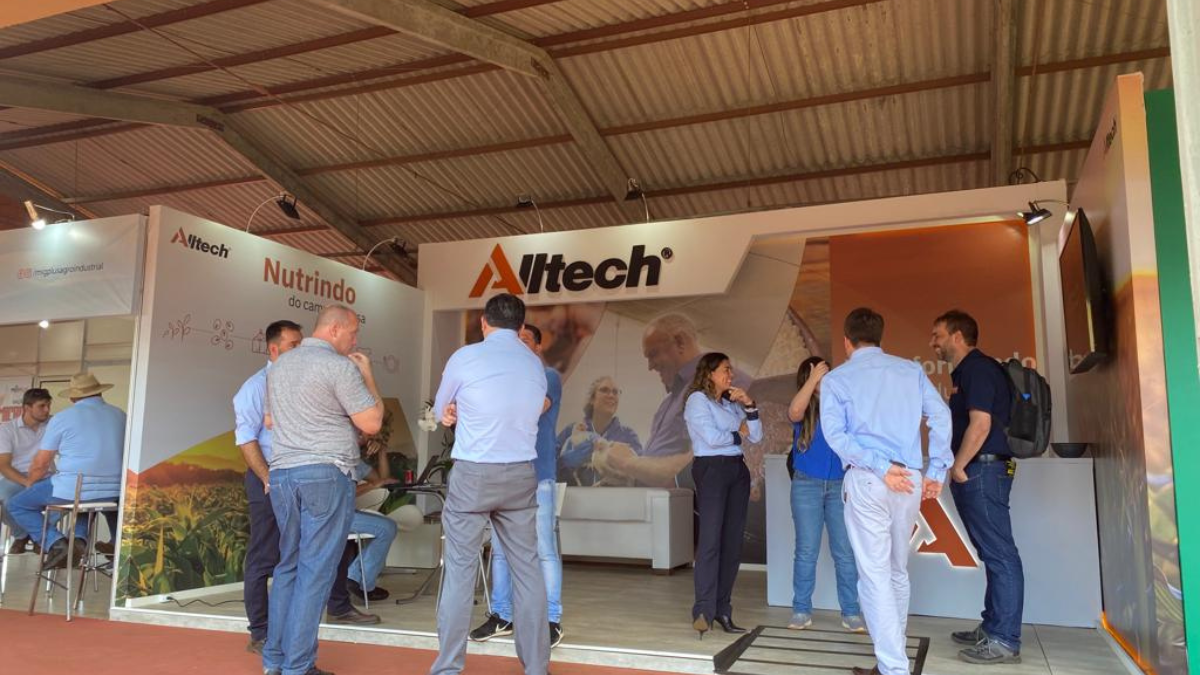
The performance of a diet feeder is central to maintaining consistent milk yields and dairy cow condition. The Maher family from Drangan, County Tipperary remain at the forefront of animal nutrition, recently upgrading their diet feeder to the latest offering from Irish manufacturer KEENAN.
Read the full Article from Farm Machinery Journal Feb 2025.pdf
